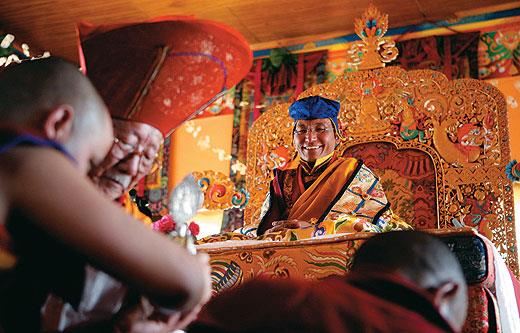If all of Ladakh was agog with this festival it’s not without reason. In the celebration of the 800th year of the Drukpa Kargyud lineage this July, the remote Himalayan outpost — widely seen as a representation of endangered Tibetan Buddhism — is reaffirming its commitment to the preservation of this ancient religion. Hemis, Ladakh’s richest and most famous monastery, is leading the celebrations but much of the action is taking place at Shey, the capital of the old Ladakhi kingdom some 20km from Leh.
Followers of the Drukpa sect have converged from all parts of Ladakh at Shey, as have Buddhists from neighbouring Kinnaur in Himachal, Bhutan, Taiwan and even Japan. As thousands of followers of the 12th incarnate Gyalwang Drukpa, the head of the Drukpa Kargyud sect, join maroon-robed monks and nuns in prayers for his long life, this means postponed trekking expeditions, closed shops, employees on leave and a general extended holiday for much of Ladakh at the peak of the tourist season.
Among the four major Buddhist sects of Ladakh, the Drukpa is also one of the oldest, founded in 1206 AD by Tsangpa Gyare, regarded as the first Gyalwang Drukpa. The monasteries of Hemis, Stakna, Chemdrey and Shey are among those that practise this form of Buddhism.
Tibetan Buddhism in Ladakh today flourishes much as it used to in medieval times. In the open-air quadrangle behind the new Naropa Palace in Shey, crowds of Ladakhis in traditional festive robes settle in uneven order to witness cham, the age-old monastic dances that symbolise the vanquishing of evil. The stark mountains rear in protective relief behind, a stab of greenery, which is Stakmo village at their foot, and the fading sun bathes the performance with a dream-like piety. The stately gonchas (traditional Ladakhi robes), the ornate peraks (head-pieces worn by women) or the cries of delight on being blessed by an incarnate lama are not for show. Nor are the wild shudderings of the oracle, who has come from far-off Kinnaur. It’s all part of an ancient tradition, flourishing virtually unadulterated till today. Oblivious to the sunscreen-smothered, Nikon-wielding foreign tourists, Drukpa followers join enthusiastically in the prayers being held to mark the occasion. The organisers have also taken this opportunity to establish a museum at Hemis monastery which houses, for the first time, all its precious artefacts under one protective roof. There are also archery and dance performances from different parts of Ladakh, Bhutan and Tibet.
And, perhaps for the first time, Ladakhis will also witness a massive fireworks display. Two truckloads of fireworks have been brought in by foreign disciples, thereby ensuring that amidst all the traditional festivity of a typical Ladakhi festival, the 800 years of the Drukpa Kargyud will also be remembered for the momentous advent of a ‘polluting’ modern influence.




